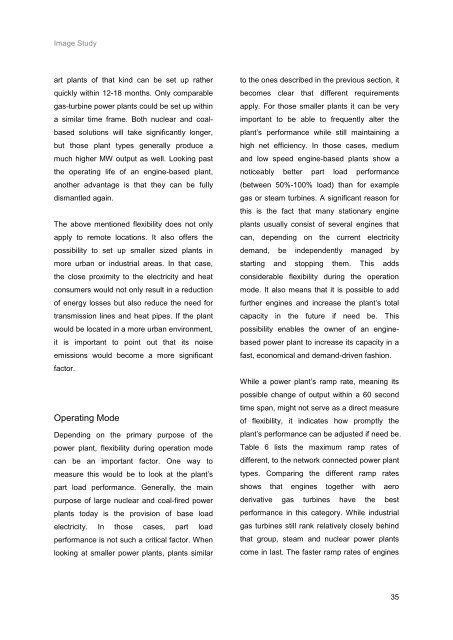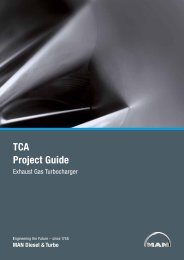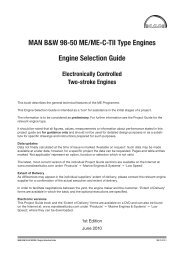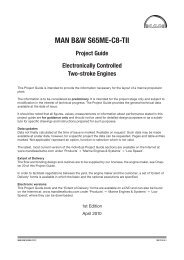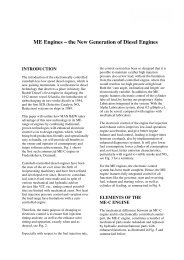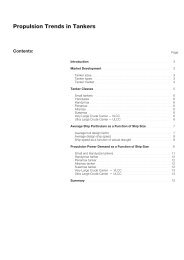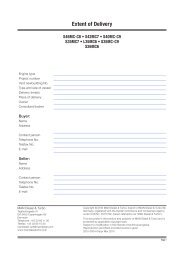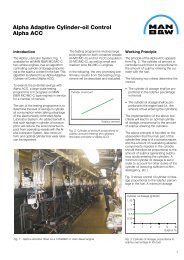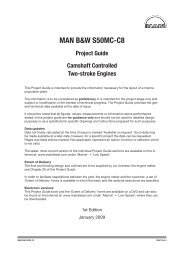Image Study Diesel Power Plants - MAN Diesel & Turbo
Image Study Diesel Power Plants - MAN Diesel & Turbo
Image Study Diesel Power Plants - MAN Diesel & Turbo
You also want an ePaper? Increase the reach of your titles
YUMPU automatically turns print PDFs into web optimized ePapers that Google loves.
<strong>Image</strong> <strong>Study</strong><br />
art plants of that kind can be set up rather<br />
quickly within 12-18 months. Only comparable<br />
gas-turbine power plants could be set up within<br />
a similar time frame. Both nuclear and coal-<br />
based solutions will take significantly longer,<br />
but those plant types generally produce a<br />
much higher MW output as well. Looking past<br />
the operating life of an engine-based plant,<br />
another advantage is that they can be fully<br />
dismantled again.<br />
The above mentioned flexibility does not only<br />
apply to remote locations. It also offers the<br />
possibility to set up smaller sized plants in<br />
more urban or industrial areas. In that case,<br />
the close proximity to the electricity and heat<br />
consumers would not only result in a reduction<br />
of energy losses but also reduce the need for<br />
transmission lines and heat pipes. If the plant<br />
would be located in a more urban environment,<br />
it is important to point out that its noise<br />
emissions would become a more significant<br />
factor.<br />
Operating Mode<br />
Depending on the primary purpose of the<br />
power plant, flexibility during operation mode<br />
can be an important factor. One way to<br />
measure this would be to look at the plant’s<br />
part load performance. Generally, the main<br />
purpose of large nuclear and coal-fired power<br />
plants today is the provision of base load<br />
electricity. In those cases, part load<br />
performance is not such a critical factor. When<br />
looking at smaller power plants, plants similar<br />
to the ones described in the previous section, it<br />
becomes clear that different requirements<br />
apply. For those smaller plants it can be very<br />
important to be able to frequently alter the<br />
plant’s performance while still maintaining a<br />
high net efficiency. In those cases, medium<br />
and low speed engine-based plants show a<br />
noticeably better part load performance<br />
(between 50%-100% load) than for example<br />
gas or steam turbines. A significant reason for<br />
this is the fact that many stationary engine<br />
plants usually consist of several engines that<br />
can, depending on the current electricity<br />
demand, be independently managed by<br />
starting and stopping them. This adds<br />
considerable flexibility during the operation<br />
mode. It also means that it is possible to add<br />
further engines and increase the plant’s total<br />
capacity in the future if need be. This<br />
possibility enables the owner of an engine-<br />
based power plant to increase its capacity in a<br />
fast, economical and demand-driven fashion.<br />
While a power plant’s ramp rate, meaning its<br />
possible change of output within a 60 second<br />
time span, might not serve as a direct measure<br />
of flexibility, it indicates how promptly the<br />
plant’s performance can be adjusted if need be.<br />
Table 6 lists the maximum ramp rates of<br />
different, to the network connected power plant<br />
types. Comparing the different ramp rates<br />
shows that engines together with aero<br />
derivative gas turbines have the best<br />
performance in this category. While industrial<br />
gas turbines still rank relatively closely behind<br />
that group, steam and nuclear power plants<br />
come in last. The faster ramp rates of engines<br />
35


